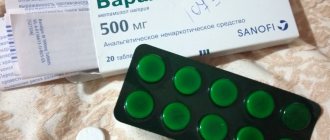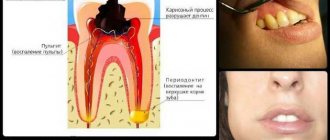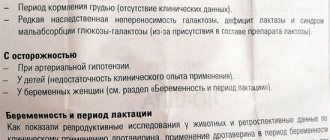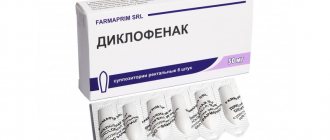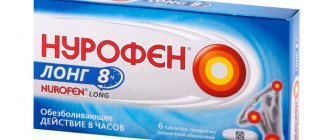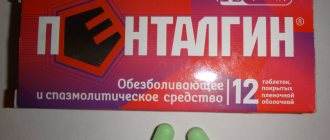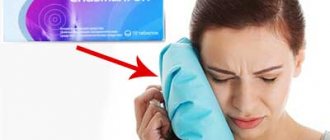pharmachologic effect
Manufacturer: Berlin-Chemie, Germany;
Laboratorios Menarini, Spain Release form: granules
Active ingredient: nimesulide
Synonyms: Nise, Nimika, Nemulex, Nimesulid-Teva, Nimulid, Nimesan
The medication refers to drugs that eliminate the inflammatory process in joints, tissues and the skeletal system.
Nimesil has the following pharmacological properties:
- analgesic;
- anti-inflammatory;
- antirheumatic;
- antipyretic.
Nimesil - instructions for use
Available in sachets with the active ingredient 100 mg for preparing a solution in packages of 9 and 30 pieces.
The suspension mixed with water is not stored; it is used in the morning and evening, 1 packet.
Nimesil for children - is it possible or not? The medication is approved for use from 12 years of age. Previously, nimesulide-containing drugs were approved for use from the 1st year of life. Later, experts discovered a side effect on small children and the instructions for use were changed.
The maximum duration of therapy with Nimesil is 15 days. To reduce the risk of side effects, the duration of treatment is minimized.
How to take Nimesil - before or after meals
To reduce the irritating effect on the walls of the stomach, the drug should be taken after meals.
Nimesil's analogs
Prices for analogues fluctuate depending on the active substance, dosage, and the country producing the medicine.
The list of Nimesil analogues is provided in the table
| Analogue | Price, in rubles | Manufacturer country |
| Nimesil | 305-725 | Spain, Germany |
| Nise | 230-270 | India |
| Arcoxia | 500-1375 | USA |
| Nimesulide | 45-182 | Russia |
| Ibuprofen | 20-165 | Russia |
| Nemulex | 100-500 | Russia |
| Movalis | 500-900 | Austria |
| Aertal | 308-845 | Spain |
| Diclofenac | 25-250 | Russia, Serbia, Germany |
| Nurofen | 55-450 | Great Britain |
| Ketanov | 60-250 | Romania |
| Ibuklin | 95-165 | Russia |
| Ketorol | 46-375 | India |
| TeraFlu | 190-530 | France |
| Meloxicam | 74-305 | China, Serbia, Israel |
| Ketonal | 185-920 | Slovenia |
| Dexalgin | 241-500 | Germany |
| Celebrex | 228-1250 | Germany, USA |
| Paracetamol | 5-130 | Russia |
| Xefocam | 275-737 | Japan |
| Okie | 330-570 | Italy |
| Pentalgin | 140-280 | Russia |
| Nimika | 200-245 | India |
| Amelotex | 128-540 | Russia |
| Ketoprofen | 70-300 | Russia |
| Nimesan | 190-210 | India |
| Voltaren | 125-700 | Switzerland |
| Faspik | 60-130 | Russia |
| Coldrex | 185-360 | Great Britain |
| Indomethacin | 70-390 | Germany, Russia |
| Texared | 150-310 | Russia |
Nise or Nimesil – which is better?
Manufacturer: Dr. Reddis, India
Release form: tablets, granules, gel
Active ingredient: nimesulide
Synonyms: Nimesil, Nimika, Nimesan
Nise is produced by the famous Indian pharmaceutical company Dr. Reddis. Sold in tablets of 20 and 30 pieces in a package, granules and in the form of a gel.
This analogue of Nimesil is effective against toothache, myalgia of various types, various types of pain: menstrual, postoperative, headache, osteochondrosis and ostearthrosis, arthritis, gout, inflammation of soft tissues.
It is also advisable to use the Nise analogue with a minimal course of therapy and doses. The medication has no effect on the further development of the disease. Used to stop pain during treatment.
Nise must be consumed after meals, maximum - 2 tablets. or 2 sachets per day.
The drugs are identical in composition, differ in the manufacturer and in that the analogue is also available in tablets. Nise is a cheaper analogue of Nimesil in powder. Everyone decides for themselves which medication is best for them.
Contraindications
In what situations is it not recommended to use Nimesil for toothache? The contraindications are as follows:
- children under 12 years of age;
- for alcohol/drug addiction;
- for diseases of an allergic nature;
- with pathology of blood clotting;
- pregnant/nursing mothers;
- for liver/kidney chronic diseases;
- for peptic ulcer of the intestines/stomach;
- in case of intolerance to the composition of the drug.
In some countries (for example, the USA), Nimesil is considered toxic and is not sold in pharmacies. However, side effects appear only if the instructions for using the medicine are violated. These include:
- nausea, vomiting and stomach pain;
- stomach bleeding (rare);
- exacerbation of kidney disease;
- labored breathing;
- increased blood pressure;
- drowsiness and apathy;
- allergic reactions;
- coma.
Disturbances in the functioning of the hematopoietic system may also be observed: thrombocytopenia, anemia, hemorrhagic syndrome. Disturbances in the functionality of the central nervous system include feelings of anxiety, fears, nightmares, headaches and drowsiness.
Heartbeat disturbances may occur - tachycardia, hot flashes. Disorders of the respiratory system include the appearance of shortness of breath, bronchospasm and attacks of bronchial asthma. There is a violation of visual function - a lack of sharpness in the perception of objects.
The effect on the renal system manifests itself in the form of urinary retention, dysuria, exacerbation of nephritis and renal failure. If the functionality of the gastrointestinal tract is impaired, exacerbations of gastritis, the appearance of jaundice, and stool disorders may occur.
However, if the dosage is observed, no toxic effects on the systems and tissues of the body have been identified. If side effects occur, you should consult a doctor. In case of overdose, symptomatic (local) treatment is prescribed. If the dosage was exceeded no later than four hours ago, induce a gag reflex and rinse the stomach. After washing, drink activated carbon (1 tablet/10 kg of weight) or take a laxative.
Side effects also appear when the medication is combined with other drugs, so it is better to notify your physician before use. Some medications may enhance or reduce the effect of the active substance of the drug.
Arcoxia or Nimesil - which is better?
Manufacturer: Merck Sharp and Dome B.V., USA
Release form: tablets
Active ingredient: etoricoxib
Synonyms: Kostarox
Arcoxia is an imported analogue of Nimesil in tablets. Available in 4 doses: 30, 60, 90 and 120 mg in packages of 7, 14 or 28 tablets. Also applies to non-steroidal anti-inflammatory drugs (NSAIDs). It has analgesic and anti-inflammatory properties.
The Nimesil analogue is indicated for:
- rheumatoid and gouty arthritis;
- osteoarthritis;
- spondylitis;
- pain syndrome after dental surgical procedures.
The Arcoxia analogue is consumed regardless of food once a day. The dose is selected taking into account the intensity of pain. Approved for use from 16 years of age. The duration of treatment should not exceed 8 days.
The doctor selects which drug is best, based on the severity of the symptoms of the disease.
TOP 12 drugs for toothache
Modern pain relievers help quickly eliminate toothache, but to achieve a 100% effect, it is important to know the principle of their action and recommendations for use.
Also, it is necessary to take into account the presence of side effects and contraindications.
Nimesil is a universal remedy, but not for everyone
It belongs to nimesulides and is not only an effective analgesic, but also a long-acting anti-inflammatory agent.
Therefore, it is more often recommended for the development of acute pulpitis, accompanied by unbearable pain (the result is noticeable after 30 minutes).
The drug is also effective in the presence of complications of pulpitis in the form of periodontitis, which involves the inflammation of the tooth ligament. Also, Nimesil is indicated for relieving pain when hard dental tissue is destroyed due to caries or injury.
Contraindicated for use in children under 12 years of age, people with heart, liver or kidney failure, chronic diseases of the stomach and intestines, allergy sufferers, pregnant and nursing mothers.
The drug is taken a maximum of 2 times a day with an interval of 12 hours. For use, dilute 1 sachet of Nimesil in half a glass of boiled warm water.
Ketorol - will help where others fail
It is a strong analgesic that simultaneously provides an anti-inflammatory effect. Ketorol is indicated for acute intense toothache, if other drugs are not able to alleviate the condition. Its effectiveness is almost similar to morphine.
Due to the risk of liver and kidney dysfunction, it is recommended for a single dose only.
The danger of long-term use is associated with the disappearance of agents responsible for pain at the site of inflammation of the pulp or nerve endings, which leads to the asymptomatic occurrence of dangerous pathologies such as periodontitis and pulpitis and the development of complications.
After taking 1 tablet of the medicine, improvement occurs after half an hour, and the maximum effect is observed after another hour.
The duration of pain relief is about 4 hours.
If the pain intensifies after 4-5 hours, you are allowed to take 1 more tablet (maximum daily dose - 4 tablets).
Ibuprofen - a classic in the service of dentistry
Ibuprofen (Nurofen) is one of the most effective drugs and helps eliminate not only toothache, but also swelling, if any, appears on the gums due to inflammation.
For particularly severe pain, Nurofen Plus is recommended, which contains codeine in addition to Ibuprofen. The drug effectively eliminates both acute and aching pain.
Take one tablet of the drug once after meals, the frequency of doses per day should not exceed 4 times.
In consultation with your doctor, if the pain is particularly unbearable, you can increase the single dose to 2 tablets, taking the drug a maximum of 3 times a day. Such therapy should be short-term.
Contraindications include children under 12 years of age, the presence of allergic reactions to non-steroids, the likelihood of hidden bleeding, exacerbation of gastrointestinal diseases, renal or liver failure, heart disease, breastfeeding and pregnancy.
Lidocaine spray - short-term but quick effect
Unlike other painkillers, the drug does not provide a long-term effect, as a result of which the pain syndrome makes itself felt again after 30-75 minutes.
Immediately after spraying the drug onto the inflamed area, the pain completely subsides due to the rapid blocking of nerve endings. The indication for use is the need for short-term pain relief.
Use 2-3 doses of Lidocaine spray (about 20 mg) one-time, the procedure is repeated after an hour and a half. The maximum number of doses per day is no more than 20.
For children, it is preferable to choose the gel form of the product, treating the inflamed area a couple of times a day. Contraindications include the presence of allergic reactions, the elderly and children under 12 years of age, epilepsy.
Novigan - a powerful remedy for toothache
Novigan, the main active ingredients of which are ibuprofen, fenpiverinium bromide and pitofenone hydrochloride, helps to quickly relieve acute pain.
Therefore, it is often recommended for the eruption of wisdom teeth, if the process is accompanied by severe discomfort. The pain subsides just a couple of minutes after taking the product.
Along with pain relief, Novigan has a mild anti-inflammatory and antispasmodic effect (if smooth muscles spasm).
The drug is taken 3 hours after a meal or an hour before eating, 1 tablet, washed down with milk (to avoid side effects from the gastrointestinal tract). Due to the risk of slowing mental and physical reactions during the period of use, it is not recommended to drive or carry out important activities.
Novigan is strictly contraindicated for children under 16 years of age and pregnant women.
What else can you take?
In search of a good and high-quality remedy for toothache, you can try the following drugs:
- Citramon . Tablets effectively relieve only moderate toothache when the inflammatory process is at the very beginning of development. The main active ingredients are paracetamol, caffeine and aspirin. To eliminate pain after meals, take 1-2 tablets (frequency of intake per day - maximum 4 times).
- Paracetamol is effective only if the toothache is not acute. For aching painful sensations, you can take 1-2 tablets at a time (after meals), repeating therapy no more than 4 times a day. The drug is contraindicated if you are allergic to NSAIDs, which include paracetamol, or if you have kidney or liver failure.
- Pentalgin . The main active ingredients are caffeine and codeine. Pentalgin quickly relieves even severe pain, delaying a recurrent attack for a long time. According to the instructions, a single dose is 1 whole tablet, the frequency of doses per day should not exceed 4 times (it is better to take the product a maximum of 3 times). Duration of treatment – no more than 5 days. Contraindications include diseases of the intestines and stomach, heart, kidney failure, anemia, periods of pregnancy and breastfeeding, children under 12 years of age.
- Ketonal . The drug based on ketoprofen is a non-steroidal drug that quickly eliminates pain and additionally eliminates inflammation. Contraindications include children under 15 years of age. While taking it, drowsiness, increased fatigue, and disturbances in digestion and appetite may develop. Recommendations for use are similar to Ketorol.
- Spasmalgon . The drug is indicated specifically for toothache, since Spazmalgon does not eliminate pain caused by other inflammations in the oral cavity. Therapy with the drug should be short-term. Take 2 tablets once, you can repeat the dose 3 times a day. Most effective for mild to moderate pain.
- Diclofenac is one of the most powerful analgesics, which also has an anti-inflammatory effect, helps to get rid of toothache in various dental pathologies. The drug is available in the form of suppositories used rectally. The initial dose is no more than 150 mg per day, divided into 2 or 3 doses. Children can be prescribed, starting from 14 years of age, 1 suppository (no more than 50 mg) a couple of times a day. Contraindications include hypersensitivity to the active substance, periods of pregnancy and lactation, liver and kidney failure and some other chronic pathologies.
- Novocaine - a drug in the form of an injection solution is used as an application by applying a cotton swab moistened with Novocaine to the diseased tooth. The product acts only on the surface of the tissue, so the pain does not go away for long. Due to the risk of developing allergies, Novocain should be used with extreme caution.
When choosing a suitable remedy for getting rid of toothache, you should remember that such a measure is temporary and only a visit to the dentist will help completely eliminate the problem, who will correctly determine the cause of the pain and provide effective therapy.
Nimesil or Nimesulide – which is better?
Manufacturer: Izvarino Pharma, Russia
Release form: tablets
Active ingredient: nimesulide
Synonyms: Naisulid, Nimesil, Nimika, Nimesan, Nise
Nimesulide and Nimesil are analogues of the active substance. The substitute is produced only in tablet form. It has an analgesic, mild antipyretic and anti-inflammatory effect.
Nimesil analogue Nimesulide is used to relieve symptoms of:
- pain, elevated temperature due to ARVI and inflammation of the upper respiratory system;
- severe pain during menstruation;
- postoperative pain;
- rheumatism.
Adults are prescribed 1-2 tablets per day after meals. For patients over 12 years of age, the dose is calculated based on body weight.
The difference between the drugs lies in the form of release and price. According to reviews, the medication in soluble form acts faster.
Nimesil and Nimesulide: how they differ and which is better
Nimesulide and Nimesil are anti-inflammatory drugs that relieve pain and eliminate inflammatory processes. Due to their similarity, it is often difficult to determine which drug is worth buying, because the differences are hard to notice. At first glance, the difference is only in price, but in reality this is not entirely true.
Nimesil
Nimesil (lat. Nimesil) are granules that are used to prepare a suspension for oral administration. Packaged in sachets containing 2 g of powder each. The product is diluted in 250 ml of water, taken 100 ml 2 times a day. Should be taken from the age of 12, with a weight of at least 40 kg.
Its range of applications is relatively wide - the solution is used for inflammation of any type, which entails a rise in temperature, and it is also used as a powerful pain reliever with a quick effect. For example, here are the cases in which it is used:
- Diseases of the musculoskeletal system.
- Arthritis.
- Colds.
- Migraine.
- For painful sensations in the postoperative period.
- Toothache.
- Gynecological, vascular, urological diseases.
This medicine is also good because it is not addictive and is often used for long-term treatment. For elderly people, the suspension should be used very carefully and the dose should be selected individually. Of course, taking this solution together with alcohol is categorically contraindicated at the same time. this can lead to negative consequences.
Nimesulide (lat. Nimesulid) can be produced either as a powder or in the form of tablets or gel. It is often sold in the form of tablets, which come in 10, 20, 30 pieces per package. The tablets are taken twice a day, one at a time. The dose should absolutely not be exceeded. The gel is used for external use.
Nimesulide is similar to its brother - it is used in the treatment of inflammatory diseases and to lower temperature. However, this medicine is used for a wider range of conditions, which include:
- Rheumatoid, psoriatic, and other types of arthritis.
- Osteochondrosis.
- Osteoarthritis.
- Inflammation of ligaments, tendons, soft tissues, as well as other types of inflammation.
- Toothache, headache, bruise pain.
- Fever.
- Cold.
The medicine is not addictive, but in no case should you exceed the prescribed dose. This can lead to many dangerous side effects. Just like Nimesil, it should be taken with caution by older people and not combined with alcohol.
Similarities and differences
the similarity of these drugs is that they are essentially the same drug, since Nimesulide is the active ingredient in both cases . Both drugs are almost completely identical. They suppress pain very well and quickly, remove inflammation and fever.
There are also significant differences that play a big role in determining which product is best for you.
The first difference between these drugs is, of course, the form of their release. One has granules, the second also has a tablet form and a gel form.
The products differ according to their indications for use. Nimesil is used in slightly more limited cases than Nimesulide. But the latter has strict dosage limits and a more extensive list of side effects. It also has many more contraindications for use than Nimesil, which should be taken into account when choosing a medicine.
The biggest difference is in price - the price of Nimesil starts from 200 rubles , while its analogue costs from 60 rubles for 20 tablets .
Because of such a difference in price, most often the choice is made on an inexpensive drug. What is the reason for this difference? Mainly only because Nimesil is a product of a European manufacturer.
Nimesulide is made by a domestic manufacturer.
So what should you choose?
When choosing a medicine, you should proceed from your personal preferences, as well as your budget.
Nimesulide is perfect for people who do not want to overpay for the brand and name of the product, as well as for those who know how to properly control the dosage of medications.
Nimesulide is almost completely identical to Nimesil, so you can easily replace an expensive drug with a cheap analogue without worrying about effectiveness. In addition, it has different release forms, which is convenient to use.
However, if the price is not important to you, you want to purchase a product from a trusted manufacturer who vouches for the quality of the product, then choose Nimesil. It has much fewer contraindications and side effects, although it is much more expensive than its counterpart.
Regardless of what you prefer, it is worth remembering: before purchasing and using, be sure to consult a doctor, because both drugs have contraindications and serious side effects, which can later cause big problems.
Source: https://vchemraznica.ru/nimesil-i-nimesulid-chem-oni-otlichayutsya-i-chto-luchshe/
Nimesil or Ibuprofen
Manufacturer: Sintez OJSC, Russia
Release form: tablets, suspension
Active ingredient: ibuprofen
Synonyms: Nurofen, Nurofast, Mig, Faspik
Ibuprofen is a domestic analogue of Nimesil. Available in the form of tablets and children's suspension. It has analgesic, antipyretic and anti-inflammatory properties. Ibuprofen is used for pain of moderate intensity:
- for arthralgia;
- for toothache;
- for neuralgic pain;
- to reduce fever during ARVI;
- with inflammation of the pelvic organs;
- after injuries.
In pediatrics it is used from 3 months (syrup). The medication is taken after meals, the dose is selected taking into account the severity of the pain syndrome.
The drugs are identical in action, they differ in age restrictions and in that the analogue Ibuprofen is effective for moderate pain, and Nimesil for severe pain.
Description of the medicine
The active ingredient of this medication is Nimesulide. It comes in the form:
- tablets;
- gel;
- syrup;
- powder.
This is a new generation medicine. It is characterized by reliability and long-term effect.
When is the medicine prescribed?
Nimesulide has the following effects:
- painkillers;
- antipyretic;
- anti-inflammatory.
It stops blood clots and suppresses histamine activity.
The use of the medication is recommended for various types of pain. It is also prescribed for dystrophic, degenerative and rheumatological pathologies.
How to drink correctly
Tablets are prescribed for adults. The maximum dosage is 1 tablet/2 times a day. If the clinical picture remains unchanged, the daily dosage can be increased to 4 tablets.
Nimesulide powder is indicated for both adults and children who have crossed the twelve-year threshold. According to the instructions, the daily dosage is 100 mg, or 1 sachet, twice a day. You cannot increase the dosage on your own.
Nimesulide syrup is prescribed to children under 12 years of age. Daily dosage - 15 ml.
Nemulex or Nimesil
Manufacturer: Sotex, Russia
Release form: granules
Active ingredient: nimesulide
Synonyms: Nimesil, Nise, Nimika
Nemulex is a complete analogue of Nimesil, cheaper. Also produced in bags. It has the following properties: relieves pain, temperature, inflammation, reduces thrombus formation.
Used to relieve pain for:
- arthritis of various origins;
- osteoarthritis;
- surgical intervention during the recovery period;
- injuries;
- menstrual and toothache;
- migraine;
- myalgia.
Nemulex can be replaced with Nimesil powder in any cases where the drug is used.
Indications for use
Nimesil is recommended for use for various pain syndromes. These may be sensations caused by the onset of menstruation, surgery, head diseases and dental problems. The drug is used to eliminate pain arising from the following pathologies:
- Gynecological
- Vascular
- Urological
Nimesil is used for pain, including toothache.
Nimesil demonstrates good effectiveness in eliminating pain caused by dysfunction of the musculoskeletal system. In addition to the main effect that the drug has, it is able to restore body temperature, regardless of the reasons that caused its increase.
Nimesil is often prescribed for toothache due to the fact that the drug has a powerful effect in relieving pain. Dentists resort to this drug because it quickly eliminates discomfort for quite a long time.
The active ingredient of the drug is nimesulide. If there is individual intolerance to individual components of Nimesil, it can be replaced with Nise, Nimica, Nimesulide, Aponil or Prolide, each of which is available in tablet form. There is another analogue called Nemulex. It is produced in powder form.
Movalis or Nimesil - which is better?
Manufacturer: Boehringer Ingelheim, Austria
Release form: tablets, ampoules, suspension, suppositories
Active ingredient: meloxicam
Synonyms: Amelotex, Movasin, Artrosan, Meloxicam Stada
Movalis is a foreign substitute for Nimesil in terms of action. It has a wide range of production forms and doses. It belongs to NSAIDs and has the following pharmacological properties: pronounced anti-inflammatory, eliminates various types of pain, relieves fever.
You can replace Nimesil with the analogue Movalis in cases of symptomatic therapy:
- osteoarthrosis (joint diseases, arthrosis);
- arthralgia;
- spondylitis.
To relieve acute pain, intramuscular injections are prescribed for 2–3 days. Then they switch to tablets or suppositories in a minimally helpful dose for a short course. The maximum dose should not be more than 15 mg per day.
With caution and under supervision, Movalis is prescribed to persons with gastrointestinal diseases.
Nimesil or Aertal - which is better?
Manufacturer: Almiral S.A., Spain
Release form: tablets, cream, sachets
Active ingredient: aceclofenac
Synonyms: Alental, Aceclofenac, Aceclagin
Airtal belongs to the new generation of diclofenac NSAIDs. Relatively easier to tolerate and has fewer side effects. It has analgesic and anti-inflammatory effects, reduces fever.
Used for rheumatic diseases, for osteoarthritis, it reduces morning stiffness from pain, reduces the inflammatory process in the joints, thereby improving the patient’s performance.
Aertal relieves the following types of pain:
- dental;
- lumbago;
- arthritic;
- damage to soft tissues by rheumatism.
Not applicable to persons under 18 years of age. Use caution if you have existing gastrointestinal disease (ulcer, gastritis).
Airtal is taken after meals, 1 sachet (tablet) twice a day in the morning and evening. The powder from the bag is mixed with water immediately before use.
Which drug is better depends on the individual. Nimesil has a wider range of indications.
Nimesil or Diclofenac
Manufacturer: Sintez AKOMP, Russia
Release form: tablets, gel, ampoules
Active ingredient: diclofenac sodium
Synonyms: Voltaren, Diclak, Dicloran
Diclofenac also refers to medications that eliminate inflammation of various etiologies. The Nimesil analogue has different forms of release and application. Produced both in Russia and in many other countries.
The Russian analogue of Nimesil Diclofenac is prescribed for:
- neuralgia (lumbago, cervical syndrome);
- rheumatism;
- worsened gout;
- arthritis;
- painful swelling;
- inflammation after surgery or injury;
- painful inflammatory processes of a non-rheumatic nature.
In the form of injections, the Diclofenac analogue is used from 1 to 5 injections per cycle of therapy, 1 per day. In exceptional cases, the dose can be increased to 2 ampoules per day. If therapy is necessary, tablets are then used. It is possible to take from 50 to 150 mg of the active substance per day, divided into several doses. Children are allowed from 6 years of age, the dose is calculated based on body weight.
Compared to Nimesil, treatment with the analogue Diclofenac is more likely to cause side effects, and it does not reduce the temperature.
Advantages and disadvantages
Inflammation is a pathological process that accompanies almost any disease. Despite the protective nature of this mechanism, inflammation is a pathology that is sought to be stopped. For this purpose, various anti-inflammatory drugs are prescribed: steroidal (hormonal) and non-steroidal (NSAIDs). The latter include Nimesil or Nimesulide, which, without interfering with the endocrine system, can suppress inflammation and pain.
Undoubtedly, the absence of a steroid structure in the NSAID molecule is an advantage of the drugs. Hormonal anti-inflammatory drugs cause quite serious side effects and addiction. Therefore, NSAIDs are widely used to relieve inflammatory reactions and relieve pain.
Disadvantages of drugs based on nimesulide
Medicines also have disadvantages, which manifest themselves in the form of a number of characteristic side effects. The mechanism of anti-inflammatory and analgesic action of the drugs is due to the following. The active substance blocks the enzyme cyclooxygenase, as a result of which a number of prostaglandins, including those involved in inflammation and pain, cease to be formed from arachidonic acid. But, in addition to relieving unpleasant symptoms, the block of prostaglandin production negatively affects the mucous membrane of the gastrointestinal tract.
Suppression of the production of gastroprotective prostaglandin can lead to the formation of erosions, gastric ulcers, and bleeding. The first signs of this side effect are pain, heartburn, nausea, and black stools. Considering the peculiarity of the action of NSAIDs, they are contraindicated during exacerbations of ulcerative pathology of the gastrointestinal tract.
Hepatotoxicity (destructive effect on the liver) is a serious drawback of nimesulide, which can cause liver damage with long-term use. For this reason, nimesulide-containing drugs were not allowed into the pharmacy markets or were withdrawn in the USA, Canada, Australia and a number of EU countries. A dose-dependent increase in the risk of drug-induced liver damage has been clinically confirmed for durations of use exceeding 30 days. Not recommended for long-term use .
Advantages of drugs based on nimesulide
The NSAID group is represented by several types of active ingredients. Ibuprofen, diclofenac, acetylsalicylic acid, indomethacin, ketoprofen, Nimesil or Nimesulide and which is better is determined by the selectivity of cyclooxygenase inhibition. The latter selectively block COX-2, which is a significant advantage of these drugs.
Selective inhibition of a variant of the cyclooxygenase enzyme results in little effect on prostaglandins that protect the stomach. But the anti-inflammatory effect remains strong. As a result, the negative effect of Nimesulide on the mucous membrane of the digestive tract becomes less significant compared to other representatives of NSAIDs. This advantage places the described drugs in a leading position in terms of effectiveness among anti-inflammatory drugs.
Analogues based on nimesulide have a very rapid onset of analgesic action, comparable to lornoxicam (Xefocam).
What to choose?
When purchasing anti-inflammatory drugs, you should pay attention to their cost. The generic will cost up to 5 times less than the original. Based on the analysis of reviews, there was no difference in effectiveness between the compared drugs. For joint pain, a gel for topical use will be effective; in addition, the negative effect on the gastric mucosa will be reduced.
If symptoms of the disease progress while taking NSAIDs, you should consult a doctor.
Nurofen or Nimesil – which is better?
Manufacturer: Reckitt Benckiser, UK
Release form: suspension, tablets, suppositories, capsules, gel
Active ingredient: ibuprofen
Synonyms: Ibuprofen, Mig, Faspik
Nurofen is an imported drug from the NSAID group. This analogue of Nimesil has antipyretic, anti-inflammatory, and analgesic effects. Produced in a variety of forms.
Destination area:
- migraine;
- toothache and menstrual pain;
- neuralgia;
- muscle pain;
- back pain;
- rheumatic pain;
- elevated temperature due to influenza or ARVI.
Nimesil substitute is used for fever in babies from 3 months in the form of syrup or suppositories. It is one of the safest medications for use in young children. The dose is calculated based on the child’s body weight and divided into 3 doses per day. Prescribed after vaccination to prevent fever.
Combination forms of Nurofen with additional components are also available for use during painful menstrual pain and ARVI. In capsules, the drug begins to act faster.
Nurofen is an analogue of Nimesil without side effects. It is easier to tolerate than other drugs and is prescribed to the youngest patients.
Which medication is best depends on the specific manifestation of pain, the age of the patient and, together with the doctor, select the drug and method of administration.
When are these drugs used?
Both medications relieve symptoms of inflammation, reduce fever and relieve pain. Indications for the use of drugs are general - symptomatic treatment of acute pain in diseases of the joints and spine of an inflammatory, degenerative, autoimmune and traumatic nature:
- arthrosis (dystrophic change in articular cartilage);
- osteochondrosis with pain syndrome;
- inflammation of joints of various etiologies;
- inflammation of tendons (tendinitis), muscles (myositis), joint capsule (bursitis);
- injuries, bruises, sprains.
In addition, both medications are prescribed to relieve toothache and painful menstruation.
Occurring side effects: diarrhea, nausea, exacerbation of bronchial asthma, allergic reactions. Hepatitis and jaundice rarely occur, and the activity of liver enzymes increases.
Nimesulide is hepatotoxic, so drugs based on it are not prescribed to people with liver diseases.
Like any NSAIDs, Nimesil and Nemulex have an impressive list of contraindications, including age under 12 years, pregnancy and breastfeeding. Before taking, please read the instructions carefully.
Nimesil or Ketanov - which is better?
Manufacturer: SK Therapy SA, Romania
Release form: ampoules, tablets
Active ingredient: ketorolac tromethamine
Synonyms: Dolak, Ketorol, Ketorolac
Ketanov refers to painkillers used for severe pain. The analgesic effect of Ketanov is stronger than that of Nimesil. An analogue is used for pain during the recovery period after surgery and for oncology. Relieves severe dental, joint and muscle pain. It is not used for the treatment of chronic pain, only for the relief of acute syndrome.
The maximum permissible dose of Ketanov's analogue per day is 9 tablets or ampoules. Treatment is carried out in the shortest possible time to reduce the likelihood of side effects.
Not for use in pregnant women, persons under 16 years of age and with acute gastrointestinal diseases.
The analogue of Nimesil Ketanov is sold only by prescription.
All medications discussed are used with caution under medical supervision in patients with ulcers or gastritis. The duration of the course should be minimal, only to eliminate the acute stage of the disease. Nimesil and analogues effectively cope with pain. The doctor selects the appropriate drug in each case.
Side effects
Exceeding the dose, prolonging the course, or simultaneous use of Nimesil with other medications may be accompanied by pathological phenomena from:
- digestive organs - dyspeptic disorders, pain in the epigastric region, jaundice;
- hematopoietic system - tendency to bleeding, anemia;
- heart and blood vessels - increased heart rate, increased blood pressure;
- respiratory organs - shortness of breath, dry cough;
- central nervous system - dizziness, drowsiness, lethargy;
- skin - allergic rashes, urticaria, itching;
- kidneys - urinary retention.
To prevent the development of undesirable consequences, the drug is taken in extremely small doses for the shortest possible time.
The occurrence of side effects is regarded as a reason to stop taking Nimesil and consult a doctor.

